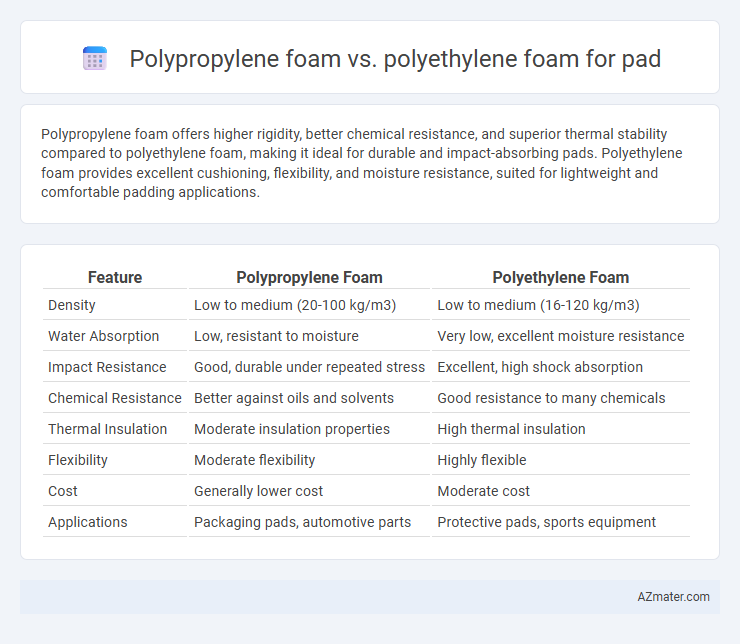Polypropylene foam offers higher rigidity, better chemical resistance, and superior thermal stability compared to polyethylene foam, making it ideal for durable and impact-absorbing pads. Polyethylene foam provides excellent cushioning, flexibility, and moisture resistance, suited for lightweight and comfortable padding applications.
Table of Comparison
| Feature | Polypropylene Foam | Polyethylene Foam |
|---|---|---|
| Density | Low to medium (20-100 kg/m3) | Low to medium (16-120 kg/m3) |
| Water Absorption | Low, resistant to moisture | Very low, excellent moisture resistance |
| Impact Resistance | Good, durable under repeated stress | Excellent, high shock absorption |
| Chemical Resistance | Better against oils and solvents | Good resistance to many chemicals |
| Thermal Insulation | Moderate insulation properties | High thermal insulation |
| Flexibility | Moderate flexibility | Highly flexible |
| Cost | Generally lower cost | Moderate cost |
| Applications | Packaging pads, automotive parts | Protective pads, sports equipment |
Introduction to Polypropylene Foam and Polyethylene Foam Pads
Polypropylene foam pads offer excellent chemical resistance, lightweight durability, and superior thermal insulation, making them ideal for industrial and packaging applications. Polyethylene foam pads, known for their closed-cell structure, provide outstanding cushioning, impact absorption, and moisture resistance, commonly used in sports equipment and protective packaging. Both materials serve as versatile padding options, with polypropylene foam emphasizing stiffness and heat resistance, while polyethylene foam excels in flexibility and shock absorption.
Chemical Structure and Composition Differences
Polypropylene foam features a semi-crystalline polymer structure composed of propylene monomers, offering higher thermal stability and rigidity compared to polyethylene foam, which consists of ethylene monomers with a more amorphous, flexible structure. The methyl side groups in polypropylene increase its chemical resistance and mechanical strength, while polyethylene's simpler hydrocarbon chain provides superior impact absorption and cushioning properties. These structural and compositional differences result in polypropylene foam pads being more durable under heat and stress, whereas polyethylene foam pads excel in shock absorption and lightweight applications.
Mechanical Properties: Durability and Strength
Polypropylene foam exhibits superior mechanical properties with higher tensile strength and better impact resistance compared to polyethylene foam, making it more durable under repeated stress. Its rigid cell structure provides enhanced compression resistance, ideal for pads requiring long-term cushioning and load-bearing capacity. Polyethylene foam offers more flexibility and resilience but has lower durability and strength, which may limit its performance in heavy-duty applications.
Cushioning Performance and Shock Absorption
Polyethylene foam offers superior cushioning performance compared to polypropylene foam due to its closed-cell structure that provides excellent impact resistance and energy absorption. Polypropylene foam, while lightweight and durable, generally exhibits lower shock absorption capacity, making polyethylene foam the preferred choice for protective pads in high-impact applications. The density and resilience of polyethylene foam enhance its ability to dissipate shock forces effectively, ensuring better protection and comfort.
Thermal Insulation Capabilities
Polypropylene foam exhibits superior thermal insulation capabilities compared to polyethylene foam due to its closed-cell structure, which effectively reduces heat transfer and provides enhanced resistance to temperature fluctuations. Polyethylene foam offers moderate insulation but tends to have higher thermal conductivity, making it less efficient in retaining heat or cold. For pad applications requiring optimal thermal performance, polypropylene foam is generally preferred due to its lower thermal conductivity and better energy retention properties.
Water and Chemical Resistance Comparison
Polypropylene foam exhibits superior water resistance compared to polyethylene foam, making it ideal for environments with high moisture exposure. In chemical resistance, polypropylene foam withstands a broader range of acids, bases, and solvents, maintaining structural integrity better than polyethylene foam. Both materials offer durability, but polypropylene foam provides enhanced protection against water absorption and chemical degradation in pad applications.
Weight and Density Considerations
Polypropylene foam offers a lower density range of 20-60 kg/m3, providing lightweight cushioning ideal for portable pads, whereas polyethylene foam typically ranges from 25-120 kg/m3, offering greater density options for enhanced durability and compression resistance. The weight advantage of polypropylene foam enables easier handling and transport without compromising structural integrity, while polyethylene foam's higher density variants deliver superior impact absorption and longevity for heavy-duty applications. Selecting between these foams requires balancing pad weight constraints against performance demands in shock absorption and long-term resilience.
Environmental Impact and Recyclability
Polypropylene foam offers a lower environmental impact due to its lower density and higher energy efficiency during production compared to polyethylene foam. Both materials are recyclable, but polypropylene foam has a higher recycling rate and produces less carbon emissions during processing. Polyethylene foam, while also recyclable, tends to have limitations in recycling infrastructure and often ends up in landfills, contributing more to environmental pollution.
Cost-effectiveness and Market Availability
Polyethylene foam generally offers better cost-effectiveness than polypropylene foam due to its lower production costs and widespread availability in the market. Polyethylene foam's extensive use in packaging and insulation sectors makes it easier to source and more competitively priced. Polypropylene foam, while offering superior chemical resistance and durability, tends to be more expensive and less readily available, impacting its overall market presence.
Ideal Applications for Pads: Polypropylene vs Polyethylene
Polypropylene foam excels in thermal insulation and chemical resistance, making it ideal for pads used in industrial packaging and automotive components where durability and heat tolerance are critical. Polyethylene foam offers superior cushioning and moisture resistance, perfect for protective pads in sports gear, medical applications, and electronics packaging. Both foams serve distinct functions depending on the required balance of rigidity, flexibility, and environmental exposure in pad applications.

Infographic: Polypropylene foam vs Polyethylene foam for Pad
 azmater.com
azmater.com